Mapping and Assessment of Tree Roots Using Ground Penetrating Radar with Low-Cost GPS
Abstract
1. Introduction
2. Aims and Objectives
3. Survey Site and Data Acquisition
4. Data Processing and Methodology
4.1. Radargram Signal Processing
4.2. Post-Processing of the Tracking Position
4.3. Kirchhoff Migration
5. Results and Discussion
5.1. 3D Migration Result
5.2. 3D Roots Detection Result
6. Conclusions
Author Contributions
Funding
Conflicts of Interest
References
- Stokes, A.; Fitter, A.H.; Courts, M.P. Responses of young trees to wind and shading: Effects on root architecture. J. Exp. Bot. 1995, 46, 1139–1146. [Google Scholar] [CrossRef]
- Coutts, M.P. Root architecture and tree stability. Plant Soil 1983, 71, 171–188. [Google Scholar] [CrossRef]
- Habermehl, A. A new non-destructive method for determining internal wood condition and decay in living trees. Part 1. Principles, method, and apparatus. Arboric. J. 1982, 6, 1–8. [Google Scholar] [CrossRef]
- Habermehl, A. A new non-destructive method for determining internal wood condition and decay in living trees. II: Results and further developments. Arboric. J. 1982, 6, 121–130. [Google Scholar] [CrossRef]
- Daniels, D.J. Ground Penetrating Radar, 2nd ed.; Institution of Engineering and Technology: London, UK, 2004. [Google Scholar]
- Harry, M.J. Ground Penetrating Radar: Theory and Application, 1st ed.; Elsevier Science: Amsterdam, The Netherlands, 2009. [Google Scholar]
- Vore, S.L.D. Ground-penetrating radar: An introduction for archaeologists. Geoarchaeology 1997, 54, 527–528. [Google Scholar] [CrossRef]
- Kaur, P.; Dana, K.J.; Romero, F.A.; Gucunski, N. Automated GPR rebar analysis for robotic bridge deck evaluation. IEEE Control Syst. Lett. 2015, 46, 2265–2276. [Google Scholar] [CrossRef]
- Zou, L.; Yi, L.; Sato, M. On the Use of Lateral Wave for the Interlayer Debonding Detecting in an Asphalt Airport Pavement Using a Multistatic GPR System. IEEE Trans. Geosci. Remote Sens. 2020, 58, 1–10, (early access). [Google Scholar] [CrossRef]
- Zhou, H.; Sato, M. Archaeological investigation in Sendai Castle using ground-penetrating radar. Archaeol. Prospect. 2001, 8, 1–11. [Google Scholar] [CrossRef]
- Sato, M.; Hamada, Y.; Feng, X.; Kong, F.N.; Zeng, Z.; Fang, G. GPR using an array antenna for landmine detection. Near Surf. Geophys. 2004, 2, 7–13. [Google Scholar] [CrossRef]
- Slob, E.; Sato, M.; Olhoeft, G. Surface and borehole ground-penetrating-radar developments. Geophysics 2010, 75, 75A103–75A120. [Google Scholar] [CrossRef]
- Hruska, J.; Čermák, J.; Šustek, S. Mapping tree root systems with ground-penetrating radar. Tree Physiol. 1999, 19, 125–130. [Google Scholar] [CrossRef] [PubMed]
- Butnor, J.R.; Doolittle, J.A.; Kress, L.; Cohen, S.; Johnsen, K.H. Use of ground-penetrating radar to study tree roots in the southeastern United States. Tree Physiol. 2001, 21, 1269–1278. [Google Scholar] [CrossRef] [PubMed]
- Barton, C.V.; Montagu, K.D. Detection of tree roots and determination of root diameters by ground penetrating radar under optimal conditions. Tree Physiol. 2004, 24, 1323–1331. [Google Scholar] [CrossRef] [PubMed]
- Butnor, J.R.; Doolittle, J.A.; Johnsen, K.H.; Samuelson, L.; Stokes, T.; Kress, L. Utility of ground-penetrating radar as a root biomass survey tool in forest systems. J. Soil Sci. 2003, 67, 1607–1615. [Google Scholar] [CrossRef]
- Hirano, Y.; Dannoura, M.; Aono, K.; Igarashi, T.; Ishii, M.; Yamase, K.; Makita, N.; Kanazawa, Y. Limiting factors in the detection of tree roots using ground-penetrating radar. Plant Soil. 2009, 319, 15. [Google Scholar] [CrossRef]
- Zenone, T.; Morelli, G.; Teobaldelli, M.; Fischanger, F.; Matteucci, M.; Sordini, M.; Armani, A.; Ferrè, C.; Chiti, T.; Seufert, G. Preliminary use of ground-penetrating radar and electrical resistivity tomography to study tree roots in pine forests and poplar plantations. Plant Physiol. 2008, 35, 1047–1058. [Google Scholar] [CrossRef]
- Liu, H.; Huang, X.Y.; Han, F.; Cui, J.; Spencer, B.F.; Xie, X.Y. Hybrid Polarimetric GPR Calibration and Elongated Object Orientation Estimation. IEEE J. Sel. Top. Appl. Earth. Obs. Remote Sens. 2019, 12, 2080–2087. [Google Scholar] [CrossRef]
- Cui, X.; Guo, L.; Chen, J.; Chen, X.; Zhu, X. Estimating tree-root biomass in different depths using ground-penetrating radar: Evidence from a controlled experiment. IEEE Trans. Geosci. Remote Sens. 2012, 51, 3410–3423. [Google Scholar] [CrossRef]
- Raz-Yaseef, N.; Koteen, L.; Baldocchi, D.D. Coarse root distribution of a semi-arid oak savanna estimated with ground penetrating radar. J. Geophys. Res. Earth Surf. 2013, 118, 135–147. [Google Scholar] [CrossRef]
- Li, W.; Cui, X.; Guo, L.; Chen, J.; Chen, X.; Cao, X. Tree Root Automatic Recognition in Ground Penetrating Radar Profiles Based on Randomized Hough Transform. Remote Sens. 2016, 8, 430. [Google Scholar] [CrossRef]
- Leucci, G. The use of three geophysical methods for 3D images of total root volume of soil in urban environments. Explor. Geophys. 2010, 41, 268–278. [Google Scholar] [CrossRef]
- Tanikawa, T.; Hirano, Y.; Dannoura, M.; Yamase, K.; Aono, K.; Ishii, M.; Igarashi, T.; Ikeno, H.; Kanazawa, Y. Root orientation can affect detection accuracy of ground-penetrating radar. Plant Soil. 2013, 373, 317–327. [Google Scholar] [CrossRef]
- Alani, A.M.; Lantini, L. Recent advances in tree root mapping and assessment using non-destructive testing methods: A focus on ground penetrating radar. Surv. Geophys. 2020, 41, 605–646. [Google Scholar] [CrossRef]
- Tosti, F.; Bianchini Ciampoli, L.; Brancadoro, M.G.; Alani, A. GPR applications in mapping the subsurface root system of street trees with road safety-critical implications. Adv. Trans. Stud. 2018, 44, 107–118. [Google Scholar]
- Zhu, S.; Huang, C.; Su, Y.; Sato, M. 3D Ground Penetrating Radar to Detect Tree Roots and Estimate Root Biomass in the Field. Remote Sens. 2014, 6, 5754–5773. [Google Scholar] [CrossRef]
- Grasmueck, M.; Viggiano, D.A. Integration of ground-penetrating radar and laser position sensors for real-time 3-D data fusion. IEEE Trans. Geosci. Remote Sens. 2007, 45, 130–137. [Google Scholar] [CrossRef]
- Böniger, U.; Tronicke, J. On the potential of kinematic GPR surveying using a self-tracking total station: Evaluating system crosstalk and latency. IEEE Trans. Geosci. Remote Sens. 2010, 48, 3792–3798. [Google Scholar] [CrossRef]
- Rial, F.I.; Pereira, M.; Lorenzo, H.; Arias, P.; Novo, A. Resolution of GPR bowtie antennas: An experimental approach. J. Appl. Geophys. 2009, 67, 367–373. [Google Scholar] [CrossRef]
- Böniger, U.; Tronicke, J. Improving the interpretability of 3D GPR data using target-specific attributes: Application to tomb detection. J. Archaeol. Sci. 2010, 37, 672–679. [Google Scholar] [CrossRef]
- Bano, M. Modelling of GPR waves for lossy media obeying a complex power law of frequency for dielectric permittivity. Geophys. Prospect. 2004, 52, 11–26. [Google Scholar] [CrossRef]
- Hanafy, S.; Al Hagrey, S.A. Ground-penetrating radar tomography for soil-moisture heterogeneity. Geophysics 2005, 71, K9–K18. [Google Scholar] [CrossRef]
- Misra, P.; Enge, P. Special issue on global positioning system. Proc. IEEE. 1999, 87, 3–15. [Google Scholar] [CrossRef]
- Dow, J.M.; Neilan, R.E.; Rizos, C. The international GNSS service in a changing landscape of global navigation satellite systems. J. Geod. 2009, 83, 191–198. [Google Scholar] [CrossRef]
- Groves, P.D. Principles of GNSS, Inertial, and Multisensor Integrated Navigation Systems; Artech House: Norwood, MA, USA, 2013. [Google Scholar]
- Hofmann-Wellenhof, B.; Lichtenegger, H.; Wasle, E. GNSS–Global Navigation Satellite Systems: GPS, GLONASS, Galileo, and More; Springer Science & Business Media: Berlin, Germany, 2007. [Google Scholar]
- Jin, S.; Feng, G.P.; Gleason, S. Remote sensing using GNSS signals: Current status and future directions. Adv. Space Res. 2011, 47, 1645–1653. [Google Scholar] [CrossRef]
- Hegarty, C.J.; Chatre, E. Evolution of the global navigation satellitesystem (gnss). Proc. IEEE 2008, 96, 1902–1917. [Google Scholar] [CrossRef]
- Teunissen, P.J. Integer least-squares theory for the GNSS compass. J. Geod. 2010, 84, 433–447. [Google Scholar] [CrossRef]
- Montenbruck, O.; Hauschild, A.; Steigenberger, P. Differential code bias estimation using multi-GNSS observations and global ionosphere maps. Navig. J. Inst. Navig. 2014, 61, 191–201. [Google Scholar] [CrossRef]
- Hoque, M.M.; Jakowski, N. Higher order ionospheric effects in precise GNSS positioning. J. Geod. 2007, 81, 259–268. [Google Scholar] [CrossRef]
- Jin, R.; Jin, S.; Feng, G. M_DCB: Matlab code for estimating GNSS satellite and receiver differential code biases. GPS Solut. 2012, 16, 541–548. [Google Scholar] [CrossRef]
- Closas, P.; Fernández-Prades, C.; Fernández-Rubio, J.A. Maximum likelihood estimation of position in GNSS. IEEE Signal Process. Lett. 2007, 14, 359–362. [Google Scholar] [CrossRef]
- Wang, N.; Yuan, Y.; Li, Z.; Montenbruck, O.; Tan, B. Determination of differential code biases with multi-GNSS observations. J. Geod. 2016, 90, 209–228. [Google Scholar] [CrossRef]
- Baselga, S.; García-Asenjo, L. GNSS differential positioning by robust estimation. J. Surv. Eng. 2008, 134, 21–25. [Google Scholar] [CrossRef]
- Pan, S.G.; Gao, W.; Wang, S.L.; Meng, X.; Wang, Q. Analysis of ill posedness in double differential ambiguity resolution of BDS. Surv. Rev. 2014, 46, 411–416. [Google Scholar] [CrossRef]
- Rife, J. Collaborative vision-integrated pseudorange error removal: Team-estimated differential GNSS corrections with no stationary reference receiver. IEEE Trans. Intell. Transp. Syst. 2011, 13, 15–24. [Google Scholar] [CrossRef]
- Petovello, M.G.; O’Keefe, K.; Lachapelle, G.; Cannon, M.E. Consideration of time-correlated errors in a Kalman filter applicable to GNSS. J. Geod. 2009, 83, 51–56. [Google Scholar] [CrossRef]
- Won, J.H.; Pany, T.; Eissfeller, B. Characteristics of Kalman filters for GNSS signal tracking loop. IEEE Trans. Aerosp. Electron. Syst. 2012, 48, 3671–3681. [Google Scholar] [CrossRef]
- Brodin, G.; Daly, P. GNSS code and carrier tracking in the presence of multipath. Int. J. Satellite Commun. 1997, 15, 25–34. [Google Scholar] [CrossRef]
- Choy, S.; Bisnath, S.; Rizos, C. Uncovering common misconceptions in GNSS Precise Point Positioning and its future prospect. GPS Solut. 2017, 21, 13–22. [Google Scholar] [CrossRef]
- Yigit, C.O. Experimental assessment of post-processed kinematic Precise Point Positioning method for structural health monitoring. Geomat. Nat. Hazards Risk 2016, 7, 360–383. [Google Scholar] [CrossRef]
- Realini, E.; Caldera, S.; Pertusini, L.; Sampietro, D. Precise Gnss Positioning Using Smart Devices. Sensors 2017, 17, 2434. [Google Scholar] [CrossRef]
- Grasmueck, M.; Weger, R.; Horstmeyer, H. Full-resolution 3D GPR imaging. Geophysics 2005, 70, K12–K19. [Google Scholar] [CrossRef]
- McClymont, A.F.; Green, A.G.; Streich, R.; Horstmeyer, H.; Tronicke, J.; Nobes, D.C.; Pettinga, J.; Campbell, J.; Langridge, R. Visualization of active faults using geometric attributes of 3D GPR data: An example from the Alpine Fault Zone, New Zealand. Geophysics 2008, 73, B11–B23. [Google Scholar] [CrossRef]
- Novo, A.; Lorenzo, H.; Rial, F.I.; Solla, M. From pseudo-3D to full-resolution GPR imaging of a complex Roman site. Near Surf. Geophys. 2012, 10, 11–15. [Google Scholar] [CrossRef]
- Zhuge, X.; Yarovoy, A.G.; Savelyev, T.; Ligthart, L. Modified Kirchhoff migration for UWB MIMO array-based radar imaging. IEEE Trans. Geosci. Remote Sens. 2010, 48, 2692–2703. [Google Scholar] [CrossRef]
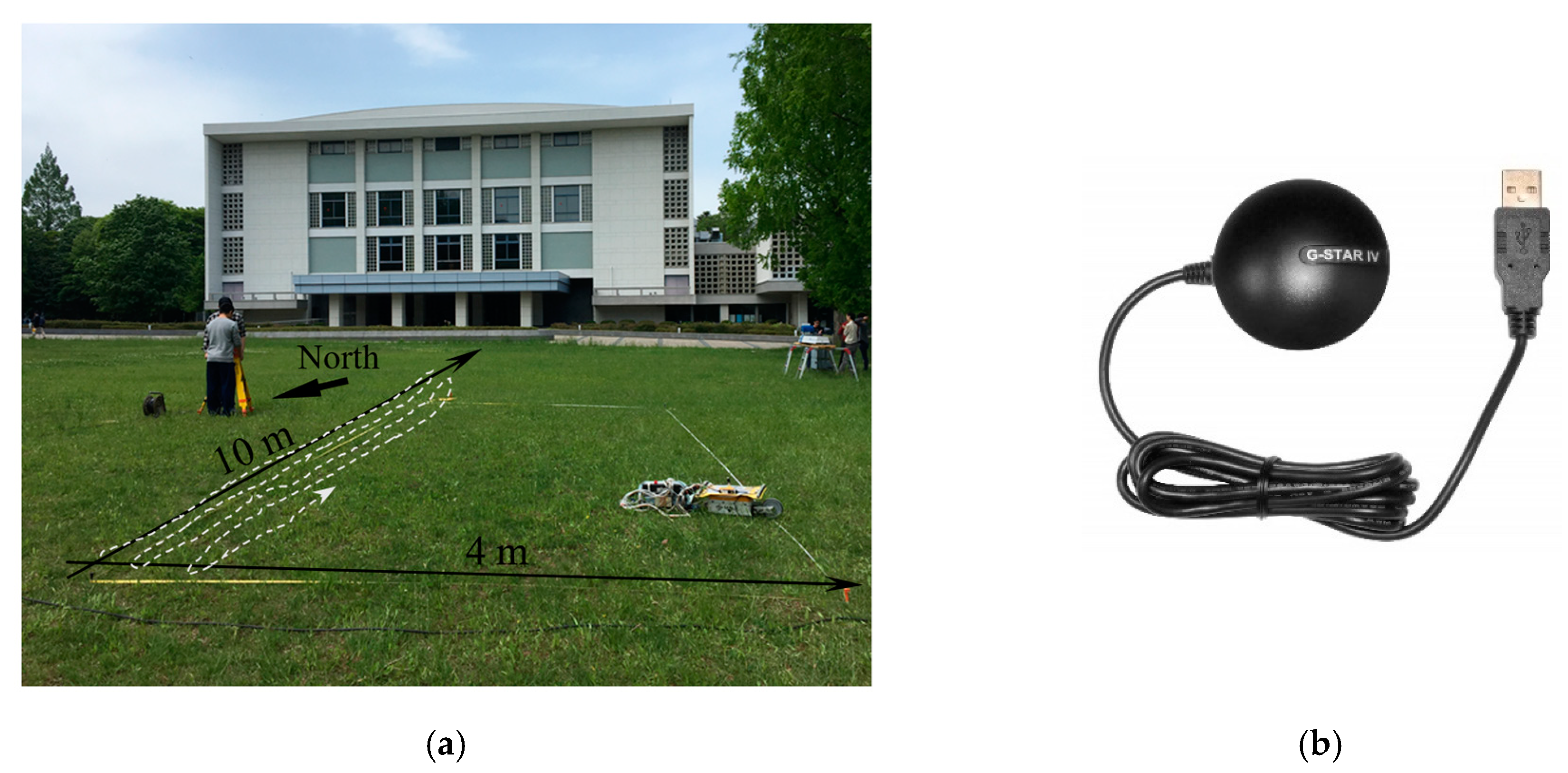
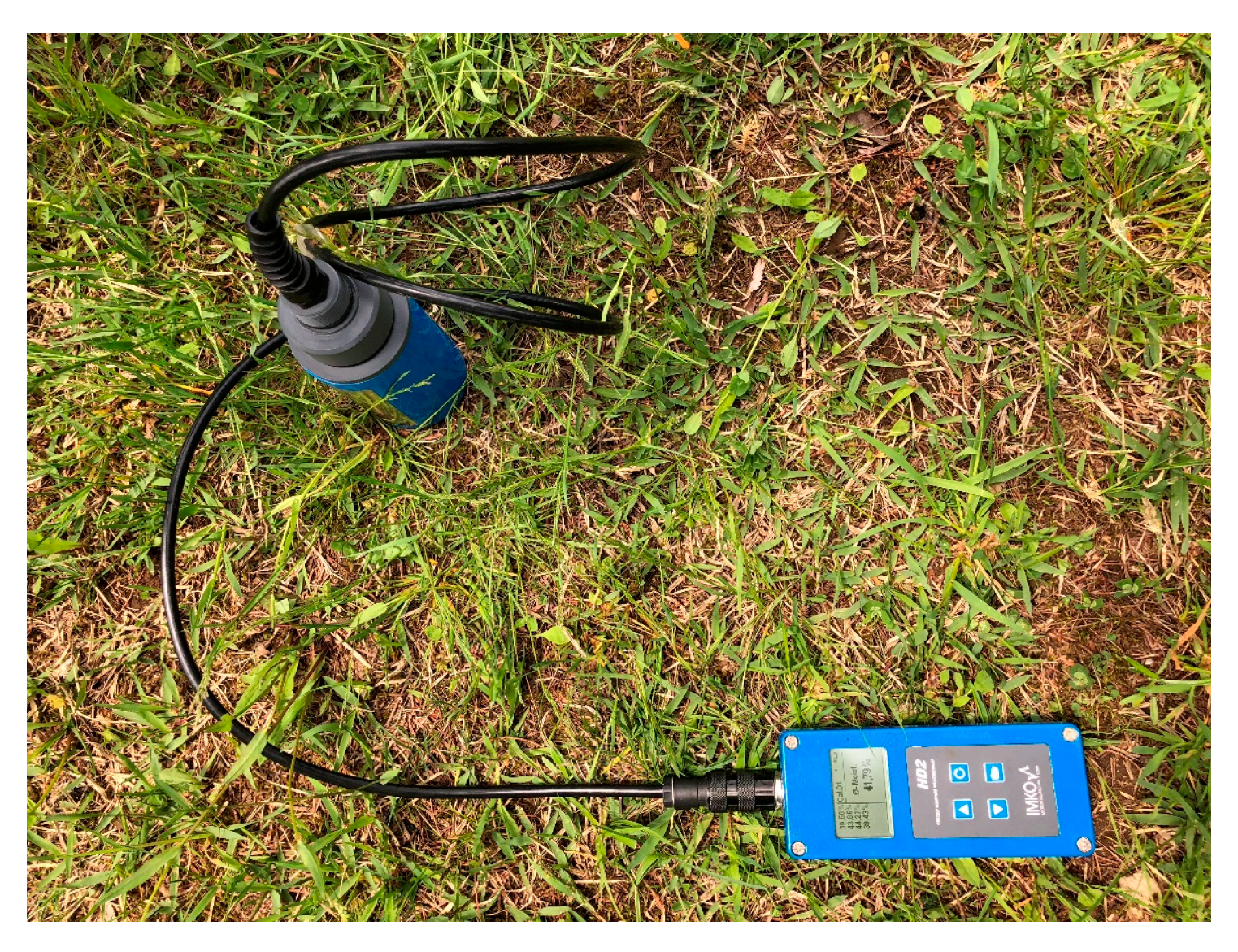
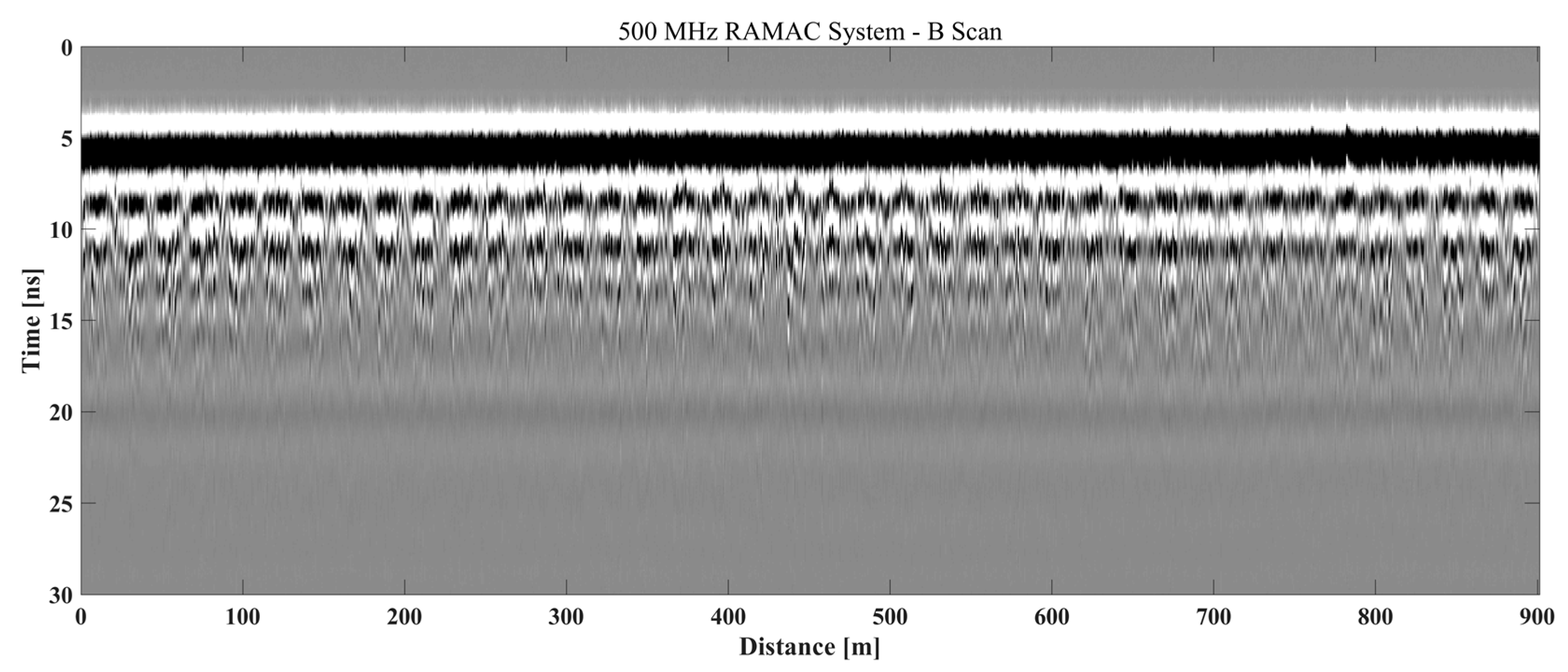
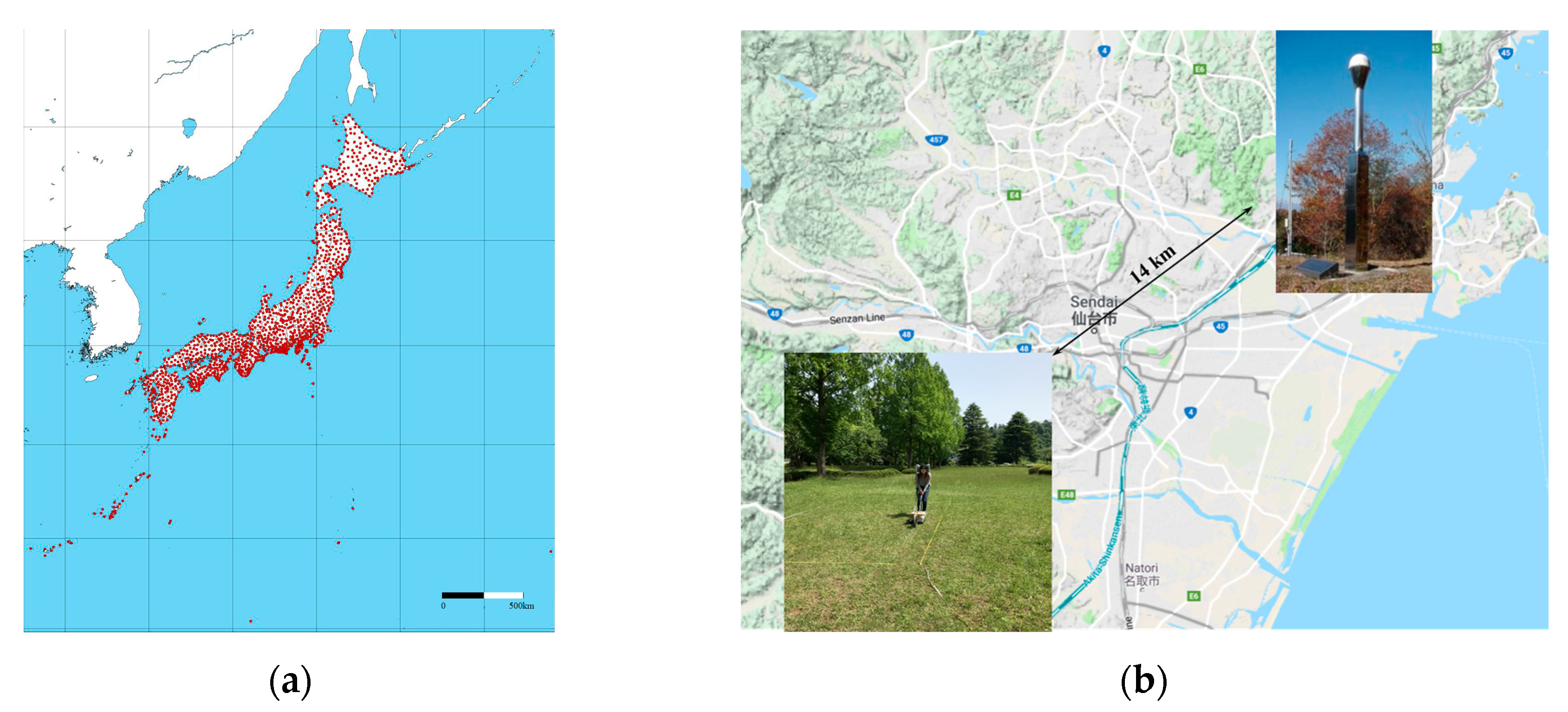
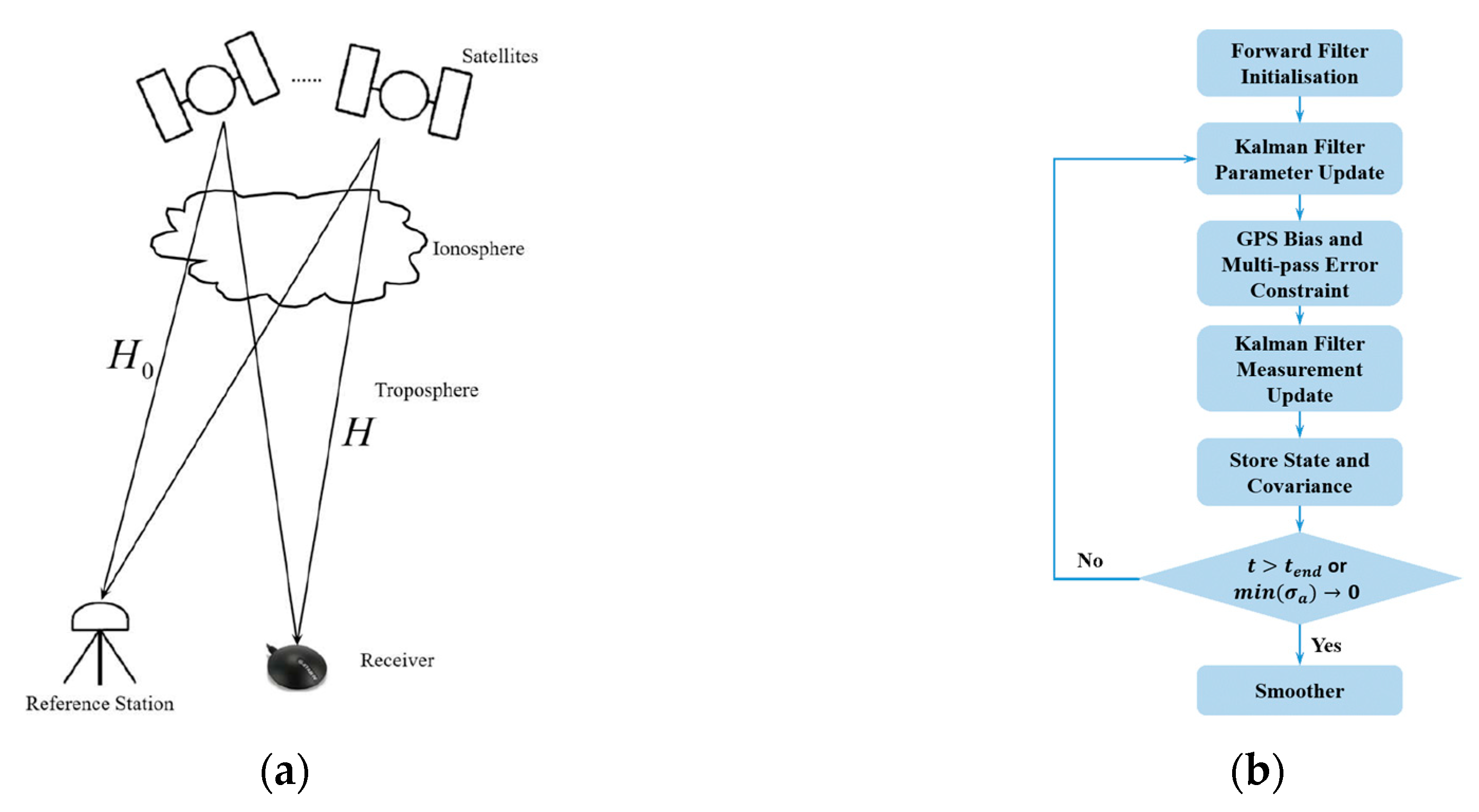
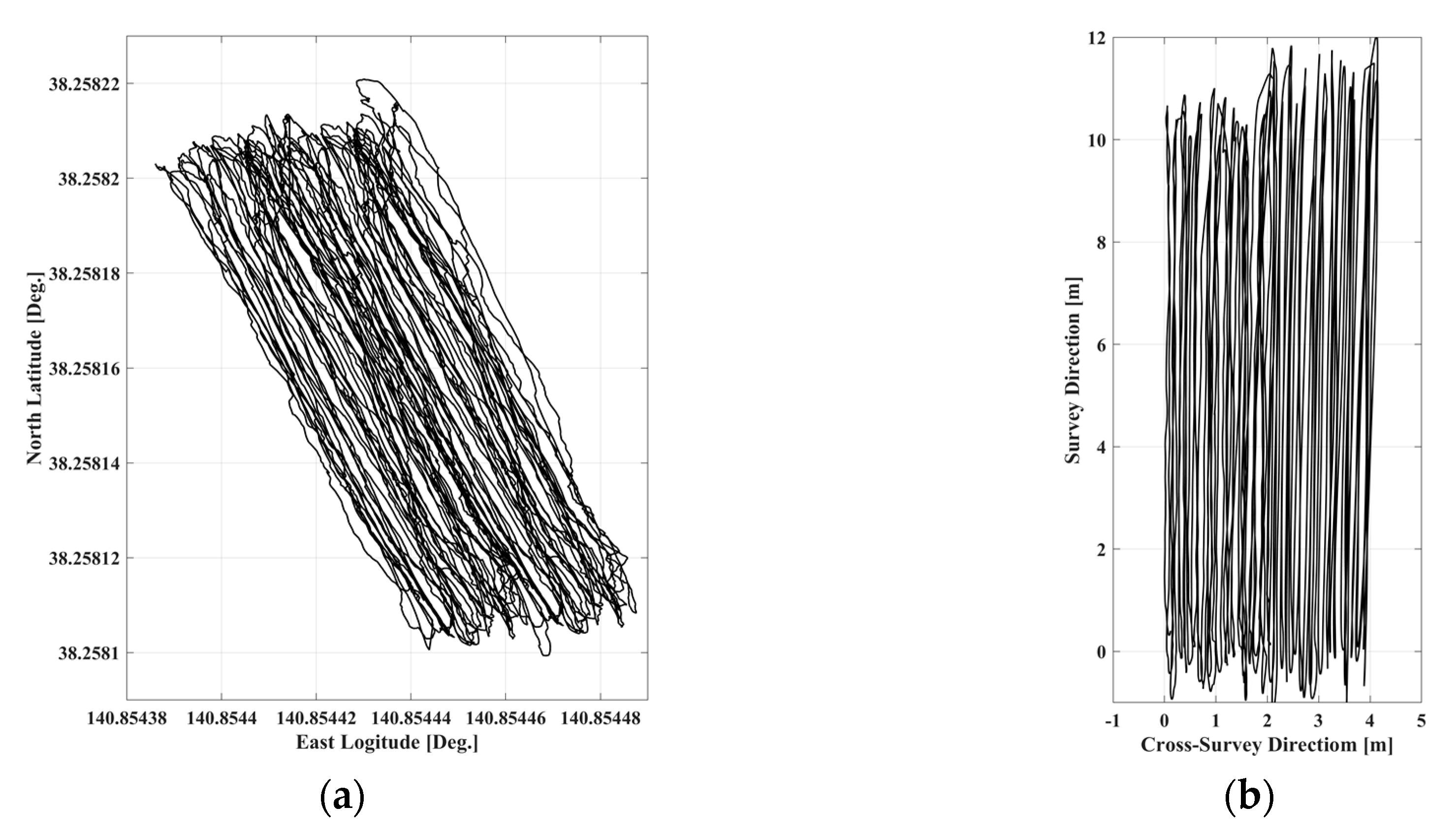
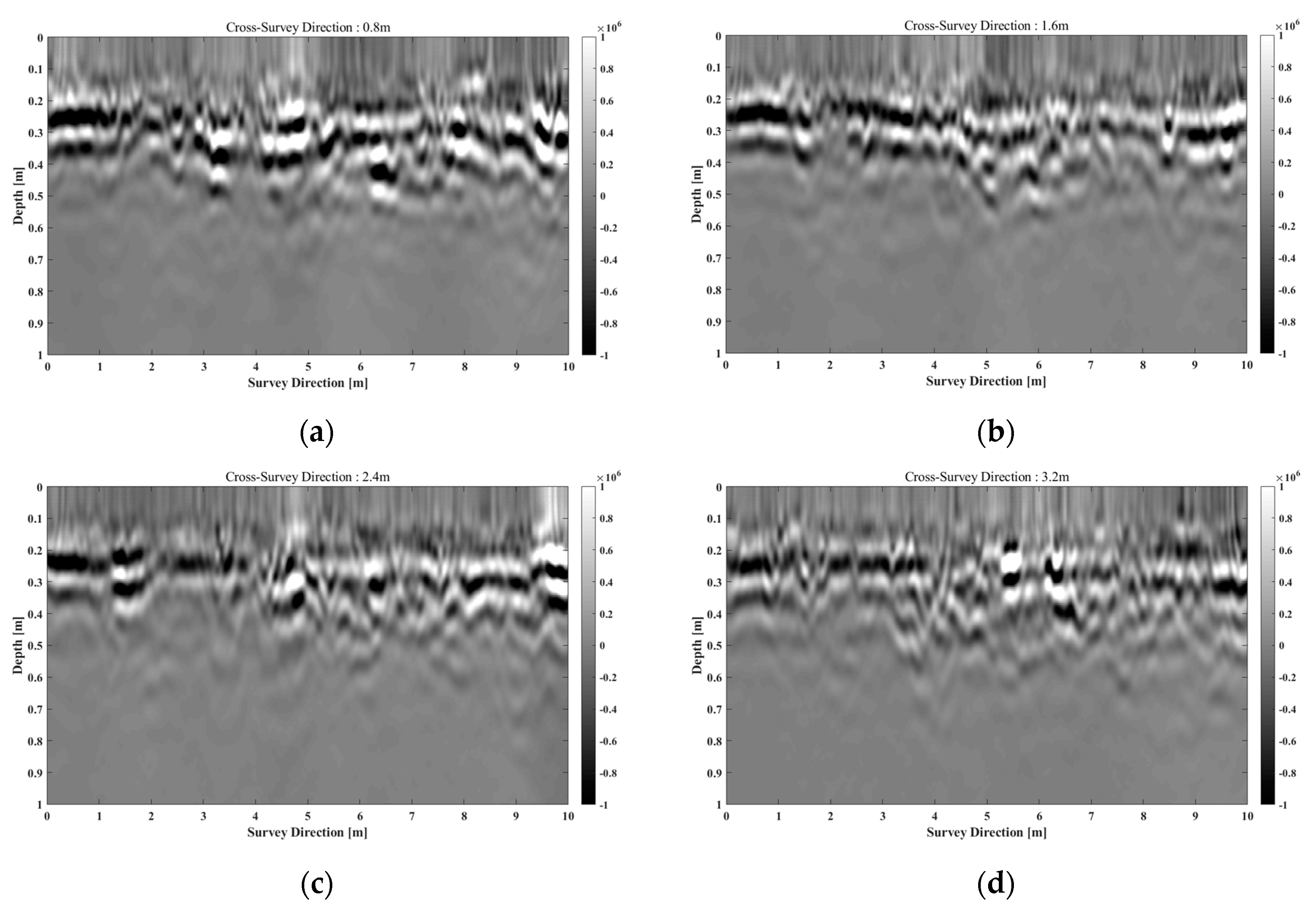
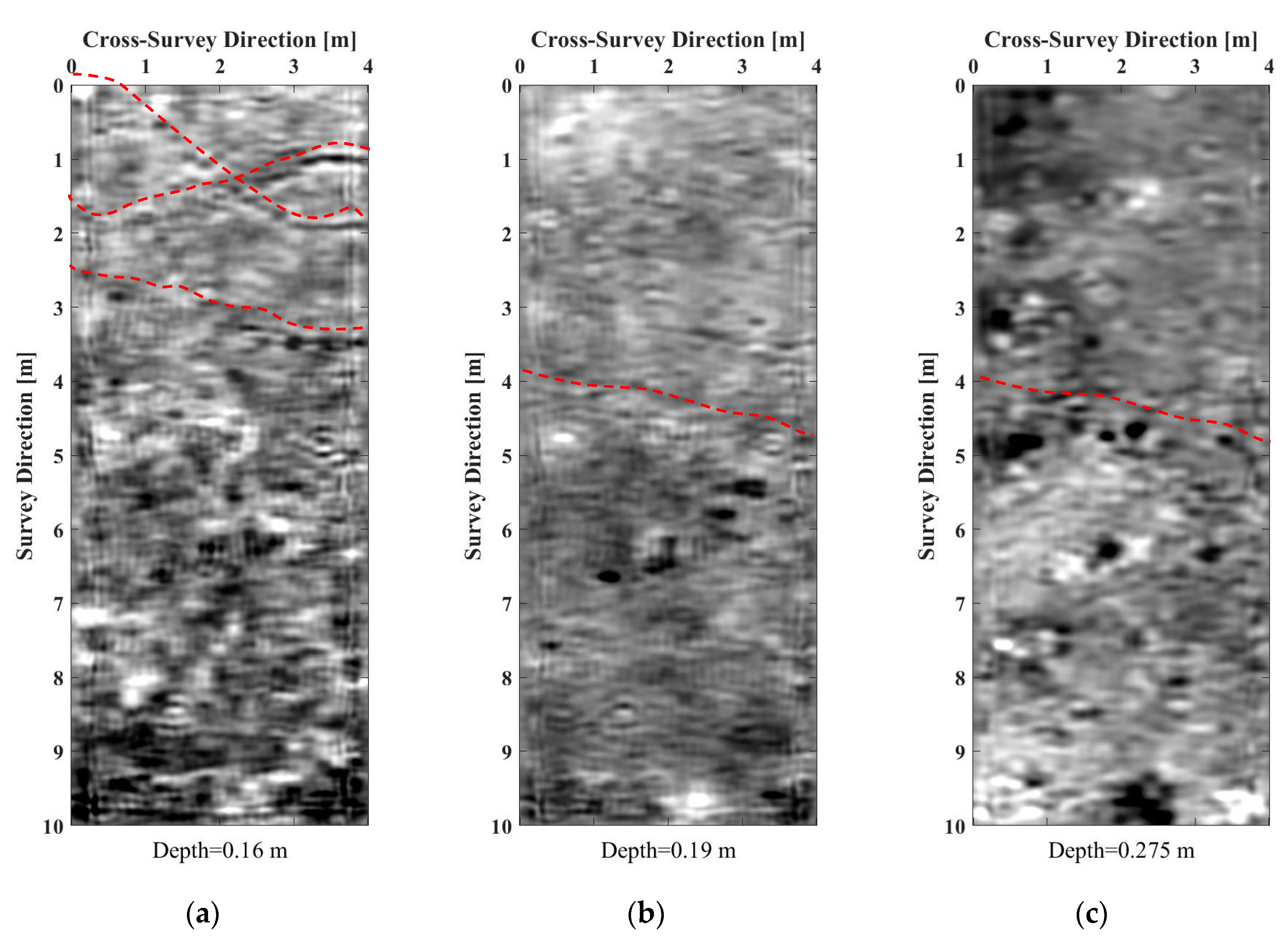
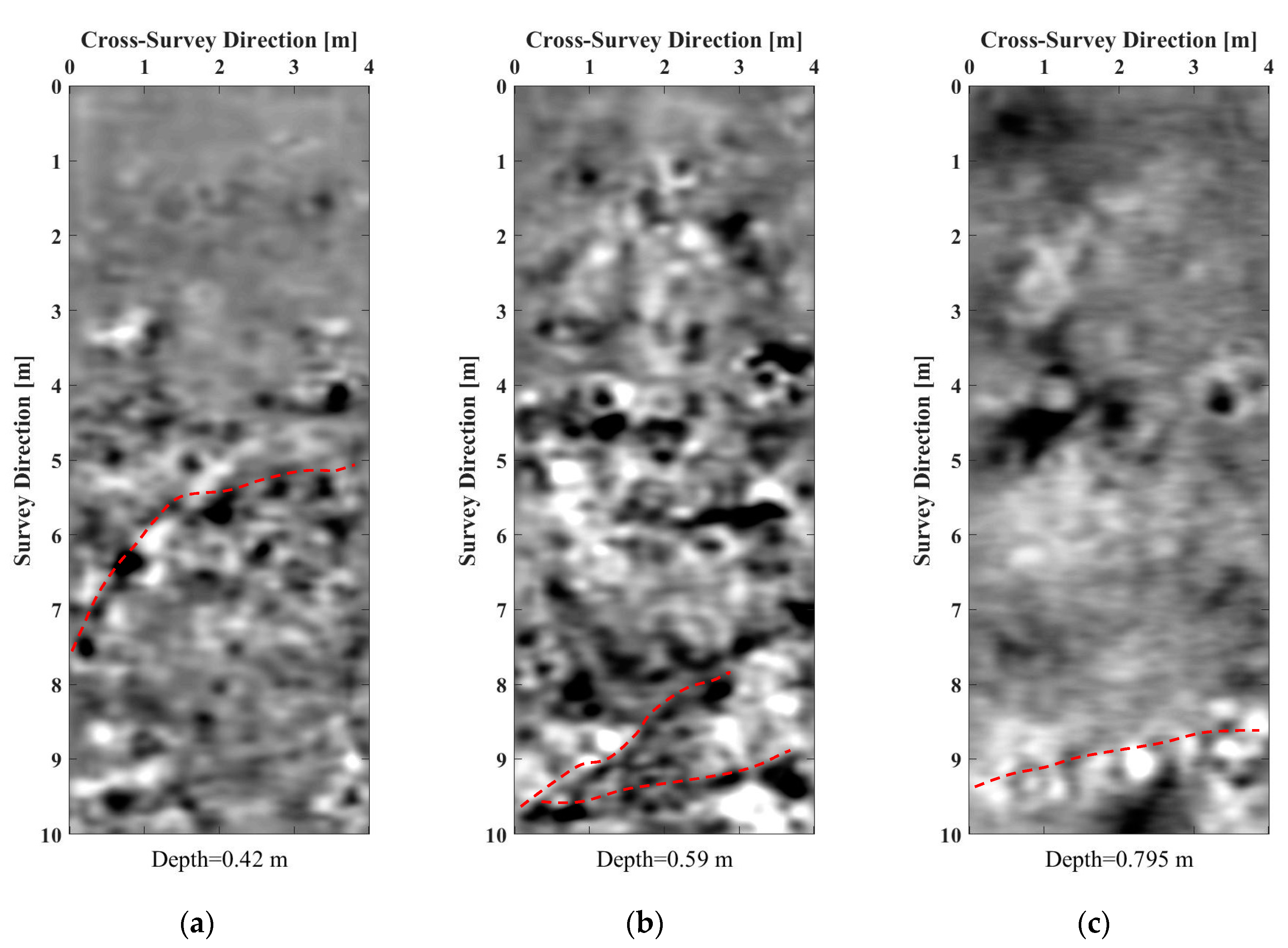
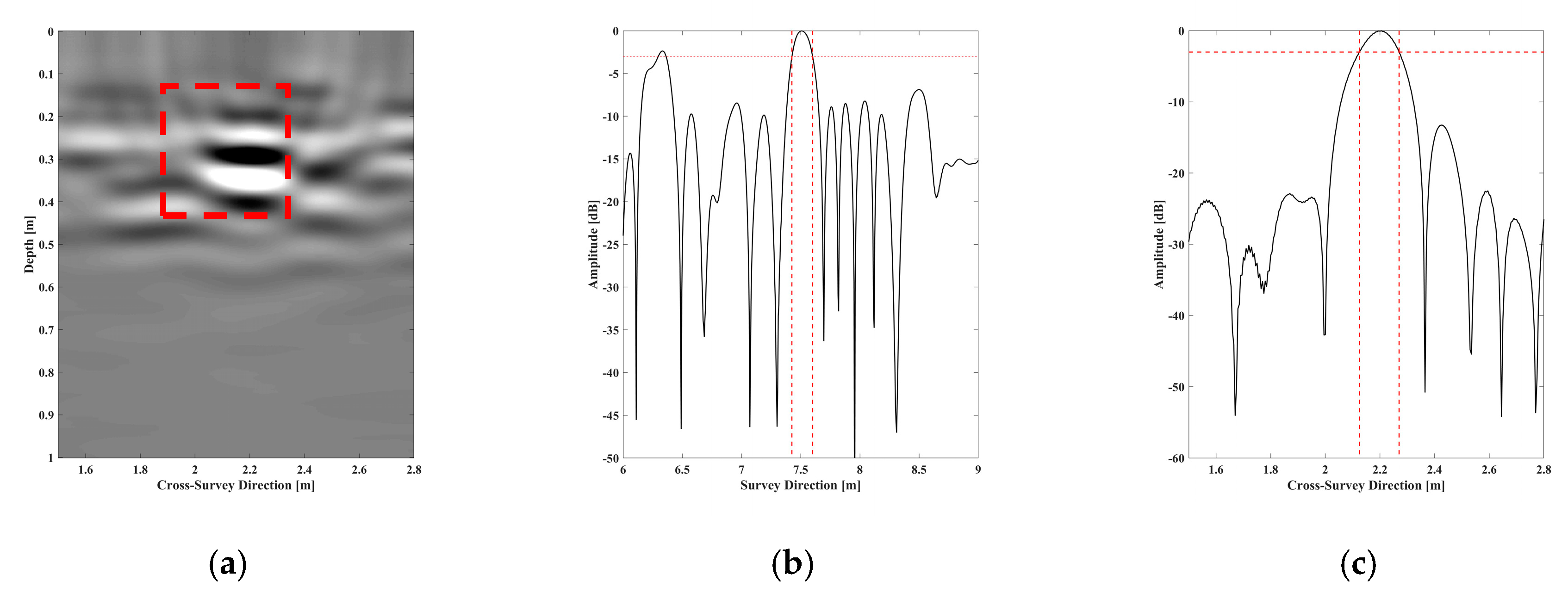
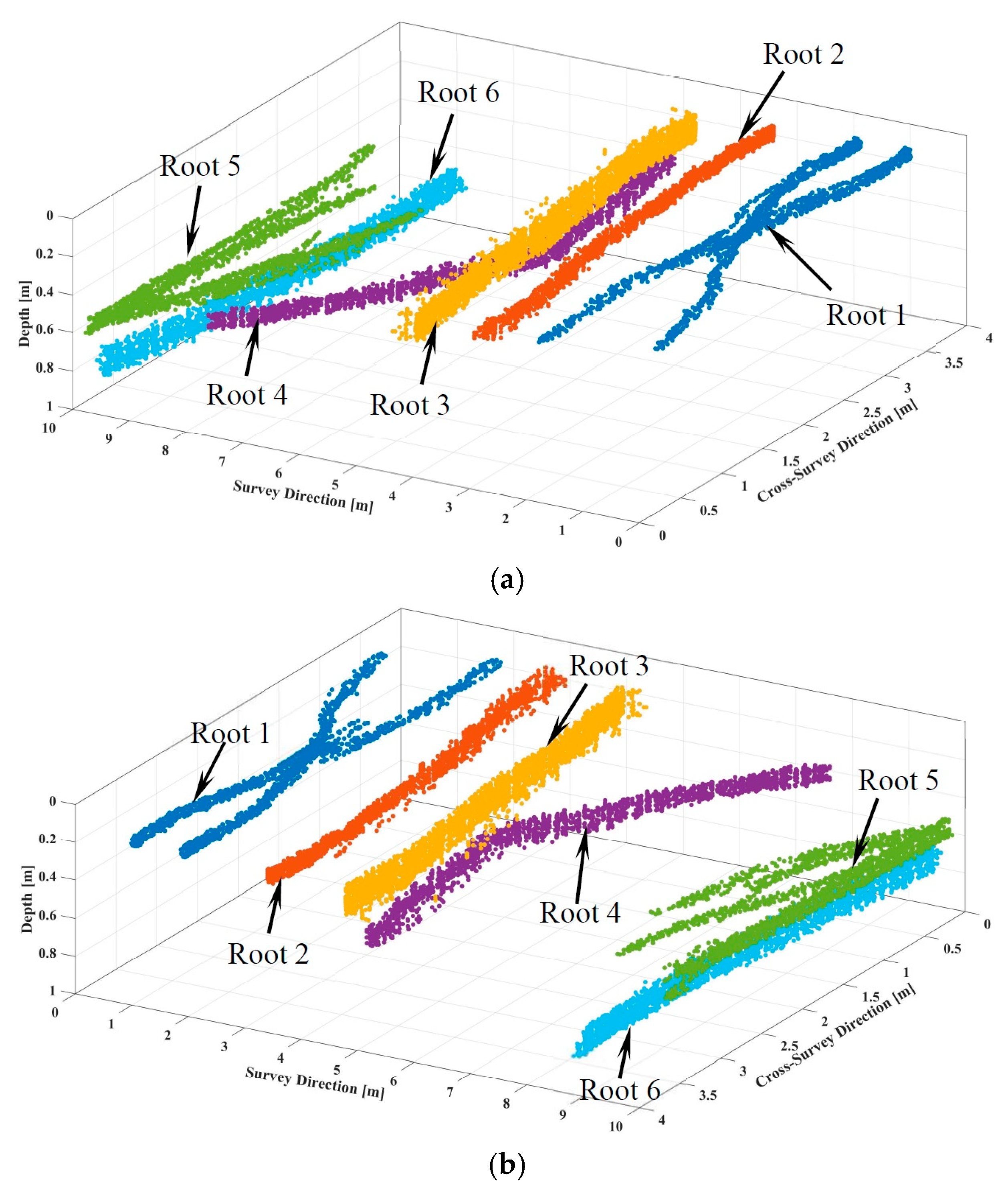
| Parameters | RAMAC 500 MHz Shielded Antenna |
|---|---|
| Limit frequency lower than −10 dB: | 138 MHz |
| Limit frequency higher than −10 dB: | 591 MHz |
| Bandwidth of −10 dB: | 453 MHz |
| Center frequency: | 364 MHz |
© 2020 by the authors. Licensee MDPI, Basel, Switzerland. This article is an open access article distributed under the terms and conditions of the Creative Commons Attribution (CC BY) license (http://creativecommons.org/licenses/by/4.0/).
Share and Cite
Zou, L.; Wang, Y.; Giannakis, I.; Tosti, F.; Alani, A.M.; Sato, M. Mapping and Assessment of Tree Roots Using Ground Penetrating Radar with Low-Cost GPS. Remote Sens. 2020, 12, 1300. https://doi.org/10.3390/rs12081300
Zou L, Wang Y, Giannakis I, Tosti F, Alani AM, Sato M. Mapping and Assessment of Tree Roots Using Ground Penetrating Radar with Low-Cost GPS. Remote Sensing. 2020; 12(8):1300. https://doi.org/10.3390/rs12081300
Chicago/Turabian StyleZou, Lilong, Yan Wang, Iraklis Giannakis, Fabio Tosti, Amir M. Alani, and Motoyuki Sato. 2020. "Mapping and Assessment of Tree Roots Using Ground Penetrating Radar with Low-Cost GPS" Remote Sensing 12, no. 8: 1300. https://doi.org/10.3390/rs12081300
APA StyleZou, L., Wang, Y., Giannakis, I., Tosti, F., Alani, A. M., & Sato, M. (2020). Mapping and Assessment of Tree Roots Using Ground Penetrating Radar with Low-Cost GPS. Remote Sensing, 12(8), 1300. https://doi.org/10.3390/rs12081300







